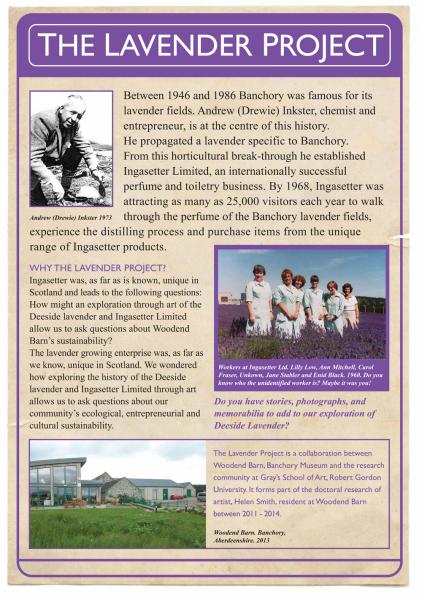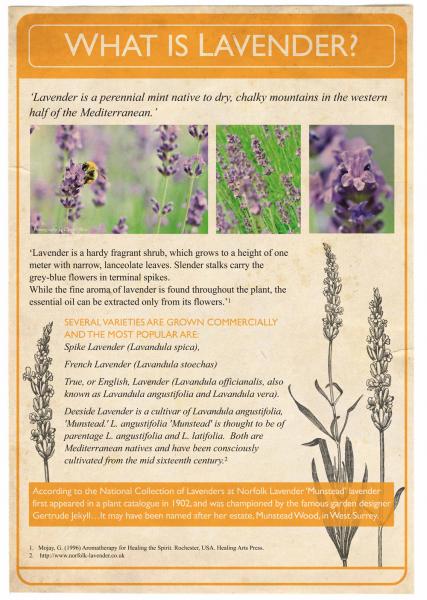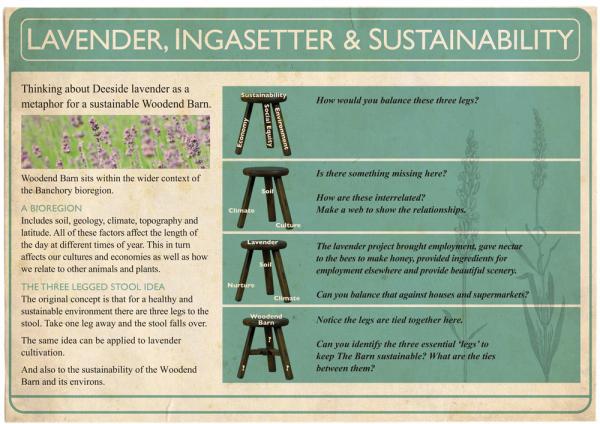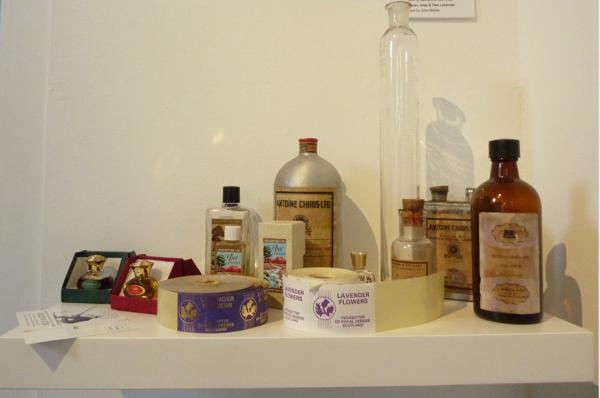The possibility of Lavender as a subject began for me as a conversation in the bar on the evening of Fiona’s birthday, (November 2012) after a Woodend Barn Music Society event. This was the first time I had heard anyone mention Banchory Lavender. Tony and Christina were telling a small circle of friends about how they had recently heard that it grew commercially in fields that could be seen from the North Deeside Road. I seem to remember a shared moment of imagining the affect of both the site and smell of fields of lavender.
1. The bar at Woodend Barn. 2. The Lavender Project opening event. 3. Lavender-pickers at Ingasetter Ltd. Banchory.
The motivation for such a project originally came from two sources: my doctoral research brief: ‘…how can these processes of creativity (artistic and organizational) best address the pressing social and economic issues of sustainability...’ (CDA August 2011). And another social moment during the interval of a film accompanied by live music at The Barn when Fiona introduced me to Genevieve who insisted that it would be good for Woodend Barn ‘To introduce the ideas and concepts that are part of ecological art to a wider audience and… to have an event that is fun and thought provoking and not too worthy’ (email G.Jones to F.Hope & H.Smith date). See CDA docs; Lavender Archive; emails.
Like artist, Allan Kaprow I was looking for a way to blur the boundaries between art and life. I perceived this to be a possible hook into the ongoing interests and interactions between participants for the sustainability aspect of my research question.
The Lavender Project evolved across my 1st year and became the milestone artwork of my 2nd year. As this project brewed in the following ways, I became the resident artist, which allowed me to interact in an open way to The Barns creative and organizational activities. One response to this period was the development, exhibition and invitation to reflect on a performative work; FOLD (2012), which in turn informed the development of The Lavender Project.
During 2012 Ideas around sustainability, art and ecology and ecological art are discussed by email and as conversations over coffee in Buchanan’s, the bistro next to The Barn. The process can be traced as a series of improvised movements between the social and formal infrastructures surrounding the organization; including visiting Genevieve’s self built eco-home in February 2012, and a meeting between Genevieve, myself and Mark, chairperson of the organization and Nicola its director. in June 2012 followed by a set of notes I produced and distributed to clarify our thoughts and get feedback. Timescales for an event and an exhibition are noted as well as a possible small amount of funding as part of a larger Year of Natural Scotland funding bid. It is agreed that I present the idea to the gallery Committee
In December 2012 an invitation is made to a group of 10 people, with a range of experiences and involvement in The Barn, to come to a New Years dinner at Mark and Fiona’s home to discuss ‘a sustainability event and exhibition’ Buchanan’s is closed for the first 2 weeks of January and so a Pot-luck supper is decided on as an alternative. The invitation notes that I have ‘received interest and support from the November gallery committee and is in the diary for August/September 2013.’
1. A gallery committee meeting at Buchanan's bistro. 2. A coach-party at Ingasetter Ltd. 3. Summer visitors at Ingasetter Ltd.
The first of Donald Schon’s 5 stages of generative metaphor, setting the conditions, can be can be traced back through the many interactions of the year leading to the dinner (Schon, date).
Many subjects were discussed, including the Alder tree and the red squirrel, while we ate, but the topic that told the richest stories and generated the most energy was The Deeside Lavender. Our approach was to select a metaphor that contained rich and interesting stories through which we could discuss the meaning of the term sustainability and in particular the specific organizational and wider sustainability of The Barn. As Paulo Friere proposes we are liberated through the experience or ‘transforming action’ of critically recognizing the nature of our own situations.
Tim Upson and Susyn Andrews in their taxonomy of ‘The Genus Lavandula’ identified a cultivar of Lavender, developed commercially by Chemist, Andrew (Drewie) Inkster, that is specific to Banchory. Once this subject was agreed the group met regularly to uncover the reasons why lavender thrived ecologically and commercially on Deeside from 1946 until it ceased trading in 1989.
1. The Lavender Project at Crathes Castle with head-gardener, Chris Wardle. 2. Bob Williamson, gardener at Ingasetter Ltd. 3. Bob distilling the lavender.
The Organization
The Barn is an interconnected social network striving to value the experience and energy of those who connect into its life outside of the hierarchical values of role and voice traditionally associated with a cultural organization. Its significance is its history of generating cultural activities in this way. This openness to people and their ideas practiced by the founders is a form of sociability characterized by its dynamic informality; fluctuating levels and types of participation over time; and ongoing desire to make sense of itself through a process of outward facing dialogues that become collaborations and partnerships.
The organizational structure that it has evolved is a central company, Woodend Arts Limited (WAL) with a board of directors who support a director of the organization and a small number of staff. WAL administrates the company and delivers a programme of music, theatre and film events. It also supports and services a family of separately constituted associations, managed and activated by interested and motivated individuals on a voluntary basis. Currently this consists of Woodend Music Society; Woodend Barn Gallery; Third Stage Group; and The Allotment Society. Other activities include caring for a wild-garden, a singing group and art classes for children and young people and an annual partnership with Aberdeen University in the delivery of an international Sound Festival.
1. Woodend Barn. 2. A conversation about sustainability on allotments. 3. Lavender story-telling in the wild-garden.
The Research
The Lavender Project asks how the experience of art, as a social process informs the way that an organization, such as Woodened Barn, pursues, for example, a dialogue about its ethos and long-term growth at a time when cultural values are shifting globally due to the redistribution of apparently diminishing resources.
If the value of this practice occurs as a from of sociability between the institution and the practice how might it inform the systems that sustain our contemporary ways of living? Or our sustainability?
1. The Lavender Project. Walking between sites of the lavender story. 2. A tea-party with employees of Ingasetter and STV filming a news item. 3. Closing discussion.
The Arts Practice
To understand how art occurs as a sociability surrounding the context and the practice I embark on a series of actions, which from my experience, I understand will reveal the nature of the institution or organization. Out of this open and dialogic practice emerges a process of sense making from which a fuller reading of the affect or change that these actions evoke can be understood. To do this I look closely for evidence of united companionship and reciprocity and their affect occurring as interactions throughout the practice. This involves a naming of the ways in which participation occurs; Observing the registers between pro-active engagement and witnessing (Lacy); Tracing sociability in the encounters between artist and participant (Kaprow); and between participants, as well as between the organizational and the individual (APG & Laderman Ukeles).
The Lavender Project as an arts practice is a social process engaged in the finding and telling of a rich story in order that those who became involved might understand the purpose of their organization more fully and develop shared knowledge about how to progress. The practice as an embodied sociability, offers new ways to understand how art generates meaning and to more fully realize the contribution art makes to society.
1.Closing discussion. 2. Making lavender seed-bombs. 3. The Ingasetter Christmas party at Banchory Lodge Hotel. 1960.
At this moment of writing (October 2013) the project can be said to have tested the first 3 stages of Schon’s process: Setting the conditions, identifying the metaphor and through the exhibition the telling of the story. The process of critical reflection during a closing programme of events involving the lavender group and a wider community has happened publicly through interacting with other models of practice. Cittedelarte in Northern Italy has been examined through a partnership research visit and a critical reading of the founding artist, Michelangelo Pistoletto’s latest manifesto and artist John Newling generously accepted an invitation to reflect on The lavender Project as a research practice. He undertook this from his own interest in making sense of the every-day through a re-valuing of its essential materiality.
As the critical reflection of the project takes place these pages will be updated.









































